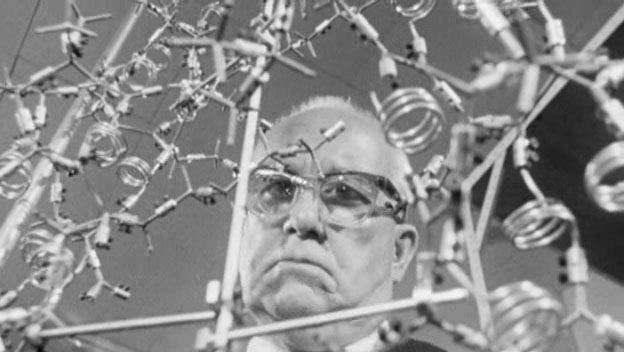The Trap and The Power of Nightmares felt like they presented central points (clearly expressed in the open of each episode), then assembled evidence in an orderly fashion, supporting their points in a complex, sometimes roundabout way. This one presents a number of points with related themes. Each episode opens with different titles and explores different events which don’t directly relate back to each other. During episode 2 I was wondering when the Ayn Rand story would come back, but during #3 I realized it had been there all along, that this time Curtis is drawing the connections without explicitly calling back to previous subjects all the time. The movies are starting to link together in interesting ways. At this point, you could fill an “art and world politics” course just by running all his movies and assigning his blog as the textbook.

Episode 1 “begins with a strange woman in the 1950’s in New York,” connects Ayn Rand with Alan Greenspan and Silicon Valley, tracing the failures of her personal life and lack of acceptance in her philosphies, comparing to their massive influence decades later among people in power over the global economy. Rand rejected altruism and supported rational egoism, so surprisingly there’s no relation to the RAND Corporation discussed in The Trap, which worked on game theory, positing human behavior as perfectly selfish.

Part 2 is about natural ecosystems, and the myth that they remain perfectly in balance – Curtis says more recent, complex models show them to be in constant flux. Loved the ecology discussions, the scientific project that attempted to precisely measure every detail of a particular field. This is shown alongside early communes (humans trying to live in perfect balance without power structures) and recent national revolts (glorious-looking uprisings by “the people” against authoritarian power, only to see it replaced by new authoritarian power a year later).

Part 3 discusses the social tendency to view people as individually unimportant parts of a large, self-balancing system. We get stories of a game-theory biologist and his colleagues who theorised that all behavior of living creatures is a result of the needs of their genes – more depowering thoughts. We close in Africa where another animal behaviorist, Dian Fossey, was working, showing how false theories on human behavior and evolution combined with the desires of technology companies led to disaster for the people of Congo/Zaire and Rwanda.

So the movie’s often-mentioned “rise of the machines” isn’t literal so much as a social-control concept, caused by simplifying models of natural behavior. It seems perfect that I finished watching this the day before seeing The World’s End, which is about the rise of actual machines that aim to simplify human behavior.

I also read a bunch of articles from Adam Curtis’s amazing blog – sadly without the video segments since I was sitting at the airport sans wifi. Essay called “You think you are a consumer but maybe you have been consumed” about Texas oilman HL Hunt, caricatured in Ken Russell’s Billion Dollar Brain. “The roots of so much of the distrust of the media today lie back with him and his ideas.” One called “Paradiabolical” on Somalia and Algeria, one on England’s history of bumbling spies, and one on animal shows before the rise of David Attenberg Attenborough.